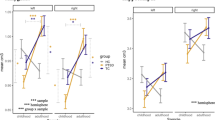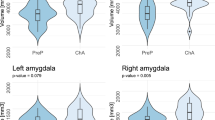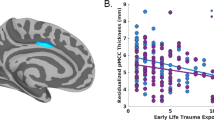Abstract
Previous studies of early life trauma suggest that in addition to its emotional impact, exposure to early life stress (ELS) is associated with alterations in brain structure. However, little attention has been devoted to the relationship between emotional processing and brain integrity as a function of age of ELS onset. In the present study we examined whether ELS onset in older ages of youth rather than younger ages is associated with smaller limbic and basal ganglia volumes as measured by magnetic resonance imaging (MRI). We hypothesized that later age of manifestation during youth is associated with smaller volumetric morphology in limbic and basal ganglia volumes in adulthood. A total of 173 individuals were divided into three groups based on the age of self-reported ELS. The three groups included individuals only experiencing early childhood ELS (1 month–7 years, n = 38), those only experiencing later childhood ELS (8 years –17 years, n = 59), and those who have not experienced ELS (n = 76). Anterior cingulate cortex (ACC), hippocampus, amygdala, insula and caudate volumes were measured using a T1-weighted MRI. Analyses confirmed that later childhood ELS was associated with volumetric reductions in the ACC and insula volumes, while ELS experienced between the ages of 1 month and 7 years was not associated with lower brain volumes in these regions. The results may reflect the influence of more fully developed emotional processing of ELS on the developing brain and reinforce a body of research implicating both the ACC and insula in neuropsychiatric disorders and emotional regulation.
Similar content being viewed by others
References
Adamec, R. (1997). Transmitter systems involved in neural plasticity underlying increased anxiety and defense–implications for understanding anxiety following traumatic stress. Neuroscience Biobehavioral Review, 21, 755–765.
Anda, R. F., Croft, J. B., Felitti, V. J., Nordenberg, D., Giles, W. H., Williamson, D. F., et al. (1999). Adverse childhood experiences and smoking during adolescence and adulthood. Journal of the American Medical Association, 282, 1652–1658.
Ashburner, J., & Friston, K. J. (2000). Voxel-based morphometry- the methods. NeuroImage, 11, 805–821.
Ashburner, J., Hutton, C., Frackowiak, R., Johnsrude, I., Price, C., & Friston, K. (1998). Identifying global anatomical differences: deformation-based morphometry. Human Brain Mapping, 6, 348–357.
Ashburner, J., Anderson, J. L. R., & Friston, K. J. (2000). Image registration using symmetric prior- in three dimensions. Human Brain Mapping, 9(4), 212–225.
Bremner, J. D. (2002). Neuroimaging studies in post-traumatic stress disorder. Current Psychiatry Report, 4, 254–263.
Bremner, J. D. (2003). Long-term effects of childhood abuse on brain and neurobiology. Child and Adolescent Psychiatric Clinics of North America, 12, 271–292.
Bremner, J. D., & Narayan, M. (1998). The effects of stress on memory and the hippocampus throughout the life cycle: implications for childhood development and aging. Developmental Psychopathology, 10, 871–885.
Bremner, J. D., Randall, P., Vermetten, E., Staib, L., Bronen, R. A., Mazure, C., et al. (1997). Magnetic resonance imaging-based measurement of hippocampal volume and posttraumatic stress disorder, related to childhood physical and sexual abuse-a preliminary report. Biological Psychiatry, 41, 23–32.
Brown, D. W., Anda, R. F., Tirmeier, H., Felitti, V. J., Croft, J. B., et al. (2009). Adverse childhood experiences and the risk of premature mortality. American Journal of Preventative Medicine, 37, 389–396.
Cicchetti, D. (2004). An odyssey of discovery: lessons learned through three decades of research on childhood maltreatment. American Psychologist, 59, 731–741.
Cohen, R. A., Grieve, S., Hoth, K. F., Paul, R. H., Sweet, L., Tate, D., et al. (2006). Early life stress and morphometry of the adult anterior cingulate cortex and caudate nuclei. Biological Psychiatry, 59(10), 975–982.
Crawford, J., & Henry, J. D. (2003). The Depression Anxiety Stress Scales (DASS): normative data and latent structure in a large non-clinical sample. British Journal of Clinical Psychology, 42, 111–131.
Davidson, R. J., & Irwin, W. (1999). The functional neuroanatomy of emotion and affective style. Trends in Cognitive Science, 3, 11–21.
De Bellis, M. D., Keshavan, M. S., & Harenski, K. A. (2001). Anterior cingulate N-acetylaspartate/creatine ratios during clonidine treatment in a maltreated child with posttraumatic stress disorder. Journal of Child and Adolescent Psychopharmacology, 11, 311–316.
Dong, M. X., Anda, R. F., Felitti, V. J., Dube, S. R., Williamson, D. F., Thompson, T. J., et al. (2004). The interrelatedness of multiple forms of childhood abuse, neglect, and household dysfunction. Child Abuse & Neglect, 28, 771–784.
Dunlop, S. A., Archer, M. A., & Quinlivan, J. A. (1997). Repeated prenatal corticosteroids delay mylenation in the ovine central nervous system. The Journal of Maternal-Fetal Medicine, 6, 309–313.
Eisenberger, N. I., Lieberman, M. D., & Williams, K. D. (2003). Does rejection hurt? An FMRI study of social exclusion. Science, 302, 290–292.
Fristron, K. J., Holmes, A., Poline, J. B., Price, C. J., & Frith, C. D. (1996). Detecting activations in PET and fMRI: levels of inference and power. NeuroImage, 4, 223–235.
Gatt, J. M., Nemeroff, C. B., Dobson-Stone, C., Paul, R. H., Bryant, R. A., et al. (2009). Interactions between BDNF Val66Met polymorphism and early life stress predict brain and arousal pathways to syndromal depression and anxiety. Molecular Psychiatry, 14, 681–695.
Gatt, J. M., Nemeroff, C. B., Schofield, P. R., Paul, R. H., Clark, C. H., Gordon, E., et al. (2010). Early life stress combined with serotonin 3A receptor and brain-derived neurotrophic factor valine 66 to methionine genotypes impacts emotional brain and arousal correlates of risk for depression. Biological Psychiatry, 68, 818–824.
Gilbertson, M. W., Shenton, M. E., Ciszewski, A., Kasai, K., Lasko, N. B., et al. (2002). Smaller hippocampal volume predicts pathologic vunerability to psychological trauma. Nature Neuroscience, 5(11), 1242–1247.
Goldstein, R. Z., Craig, A. D., Bechara, A., Garavan, H., Childress, A. R., Paulus, M. P., et al. (2009). The neurocircuitry of impaired insight in drug addiction. Trends in Cognitive Science, 213, 372–380.
Gordon, E. (2003). Integrative neuroscience. Neuropsychopharmacology 28. Supplement, 1, S2–S8.
Gray, J. R., Braver, T. S., & Raichle, M. E. (2002). Integration of emotion and cognition in the lateral prefrontal cortex. Proceedings of the National Academy of Science, 99(6), 4115–4120.
Gunner, M. R., Wewerka, S., Frenn, K., Long, J. D., & Griggs, C. (2009). Developmental changes in the hypothalamus pituitary-adrenal acitivity over the transition to adolescence: normative changes and association with puberty. Developmental Psychopathology, 21, 69–85.
Hardt, J., & Rutter, M. (2004). Validity of adult retrospective reports of adverse childhood experiences: review of the evidence. Journal of Child Psychology and Psychiatry, 45, 260–273.
Harrison, P. A., Fulkerson, J. A., & Beebe, T. J. (1997). Multiple substance use among adolescent physical and sexual abuse victims. Child Abuse & Neglect, 21, 529–539.
Heatherton, T. F. (2011). Neuroscience of self and self-regulation. Annual Reviews of Psychology, 62, 363–390.
Hickie, I. B., Davenport, T. A., Naismith, S. L., & Scott, E. M. (2001). SPHERE: a national depression project. The Medical Journal of Australia, 175, S4–S5.
Infrasca, R. (2003). Childhood adversities and adult depression: an experimental study on childhood depressogenic markers. Journal of Affective Disorders, 76, 103–111.
Kalivas, P. W., & Volkow, N. D. (2005). The neural basis of addiction: a pathology of motivation and choice. The American Journal of Psychiatry, 162, 1403–1413.
Koenen, K. C., Roberts, A., Stone, D., & Dunn, E. (2010). The epidemiology of early childhood trauma. In R Lanius, E. Vermetten & C. Pain (Eds.), The Impact of Early Life Trauma on Health and Disease: The Hidden Epidemic (1 ed.). Cambridge. Cambridge University Press.
Lauder, J. M. (1988). Neurotransmitters as morphogens. Progress in Brain Research, 73, 365–387.
Levitan, R. D., Rector, N. A., Sheldon, T., & Goering, P. (2003). Childhood adversity associated with major depression and/or anxiety disorders in a community sample of Ontario: issues of co-morbidity and specificity. Depression and Anxiety, 17(1), 34–42.
Li, C. S., & Sinha, R. (2008). Inhibitory control and emotional stress regulation: neuroimaging evidence for frontal-limbic dysfunction in psycho-stimulant addiction. Neuroscience and Biobehavoral Reviews, 32, 581–597.
Lovibond, P. F., & Lovibond, S. H. (2005). The structure of negative emotional states comparison of the Depression Anxiety Stress Scales (DASS) with the Beck Depression and Anxiety Inventories. Behavioral and Respiratory Therapy, 33, 335–343.
Lupien, S. J., McEwen, B. S., Gunnar, M. R., & Heim, C. (2009). Effects of stress throughout the lifespan on the brain, behaviour and cognition. Nature Reviews Neuroscience, 10, 434–445.
McCormick, C. M., & Mathews, I. Z. (2007). HPA function in adolescence: role of sex hormones in the regulation and the enduring consequences of exposure to stressors. Pharmacological Biochemistry and Behavior, 86, 220–233.
McFarlane, A., Clark, C. R., Bryant, R. A., Williams, L. M., Niaura, R., Paul, R. H., et al. (2005). The impact of early life stress on psychophysiological, personality and behavioral measures in 740 nonclinical subjects. Journal of Integrated Neuroscience, 2, 27–40.
McGee, R. A., Wolfe, D. A., Yuen, S. A., Wilson, S. K., & Carnochan, J. (1995). The measurement of maltreatment: a comparison of approaches. Child Abuse & Neglect, 19, 233–249.
Morey, R. A., Hariri, A. R., Gold, A. L., Hauser, M. A., Munger, H. J., et al. (2011). Serotonin transporter gene polymorphisms and brain function during emotional distraction from cognitive processing in posttraumatic stress disorder. BMC Psychiatry, 11, 76.
Naqvi, N. H., Rudrauf, D., Damasio, H., & Bechara, A. (2007). Damage to the insula disrupts addiction to cigarette smoking. Science, 315, 531–534.
Paul, R. H., Haque, O., Gunstad, J., Tate, D. F., Grieve, S. M., Hoth, K., et al. (2005). Subcortical hyperintensities impact cognitive function among a select subset of healthy elderly. Archives of Clinical Neuropsychology, 20, 697–704.
Paulus, M. P., & Stein, M. B. (2010). Interoception in anxiety and depression. Brain Structure & Function, 214, 451–463.
Pechtel, P., & Pizzagalli, D. A. (2001). Effects of early life stress on cognitive and affective function: an integrated review of human literature. Psychopharmacology, 214(1), 55–70.
Penza, K. M., Heim, C., & Nemeroff, C. B. (2003). Neurobiological effects of childhood abuse: implications for the pathophysiology of depression and anxiety. Archives of Women's Mental Health, 6, 15–22.
Romeo, R. D., Bellani, R., Karatsoeros, I. N., Chhua, N., Vernov, M., Conrad, C. D., et al. (2006). Stress history and pubertal development interact to shape hypo-pituitary-adrenal axis plasticity. Pharmacological Biochemistry and Behavior, 86, 220–230.
Salmond, C. H., Ashburner, J., Vargha-Khadem, F., Connelly, A., Gadian, D. G., & Friston, K. J. (2002). The precision of anatomical normalization in the medial temportal lobe using spatial basis functions. NeuroImage, 17, 507–551.
Sanders, B., & Becker-Lausen, E. (1995). The measurement of psychological maltreatment data on child abuse and trauma scale. Child Abuse & Neglect, 19, 315–323.
Sapolsky, R. M., Uno, H., Rebert, C. S., & Finch, C. E. (1990). Hippocampal damage associated with prolonged glucocorticoid exposure in primates. The Journal of Neuroscience, 10, 2897–2902.
Shea, A., Walsh, C., Macmillan, H., & Steiner, M. (2005). Child maltreatment and HPA axis dysregulation: relationship to major depressive disorder and post-traumatic stress disorder in females. Psychoneuroendocrinology, 30, 162–178.
Sinha, R. (2008). Chronic stress, drug use, and vulnerability to addiction. Annals of the New York Academy of Sciences, 1141, 105–130.
Stein, M. B., & Paulus, M. P. (2009). Imbalance of approach and avoidance: the yin and yang of anxiety disorders. Biological Psychiatry, 66, 1072–1074.
Stroud, L. R., Foster, E., Papandonatos, G. D., Handweger, K., Granger, D. A., Kivlighan, K. T., et al. (2009). Stress response and the adolescent transition: performance versus rejection stressors. Developmental Psychopathology, 21, 47–68.
Tzourio-Mazoyer, N., Landeau, B., Papathanassiou, D., Crivello, F., Etard, O., Delcroix, N., et al. (2002). Automated anatomical labeling of activations in SPM using a macroscopic anatomical parcellation of the MNI MRI single-subject brain. NeuroImage, 15, 273–289.
Uno, H., Esiele, S., Sakaim, A., Shelton, S., Baker, E., DeJesus, O., et al. (1994). Neurotoxicity of glucocorticoids in the primate brain. Hormones and Behavior, 28, 336–346.
Wessing, I., Furniss, T., Zwitserlood, P., Dobel, C., & Junghofer, M. (2011). Early emotion discrimination in 8- to 10-year old children: magnetoencephalographic correlates. Biological Psychology, 88, 161–169.
Whittington, C. J., Kendall, T., Fonagy, P., Cottrell, D., Cotgrove, A., & Boddington, E. (2004). Selective serotonin reuptake inhibitors in childhood depression: systematic review of published versus unpublished data. Lancet, 363, 1341–1345.
Young, E. A., Abelson, J. L., Curtis, G. C., & Nesse, R. M. (1997). Childhood adversity and vulnerability to mood and anxiety disorders. Depression and Anxiety, 5, 66–72.
Acknowledgments
This work was supported by the Brain Research International Database (under the auspices of the Brain Resource Company), for use of both testing battery and data.
A portion of the data presented here was presented at the 2012 annual American Psychological Association meeting.
Author information
Authors and Affiliations
Corresponding author
Rights and permissions
About this article
Cite this article
Baker, L.M., Williams, L.M., Korgaonkar, M.S. et al. Impact of early vs. late childhood early life stress on brain morphometrics. Brain Imaging and Behavior 7, 196–203 (2013). https://doi.org/10.1007/s11682-012-9215-y
Published:
Issue Date:
DOI: https://doi.org/10.1007/s11682-012-9215-y




